Must-Know Water Safety Tips For Adults & Children
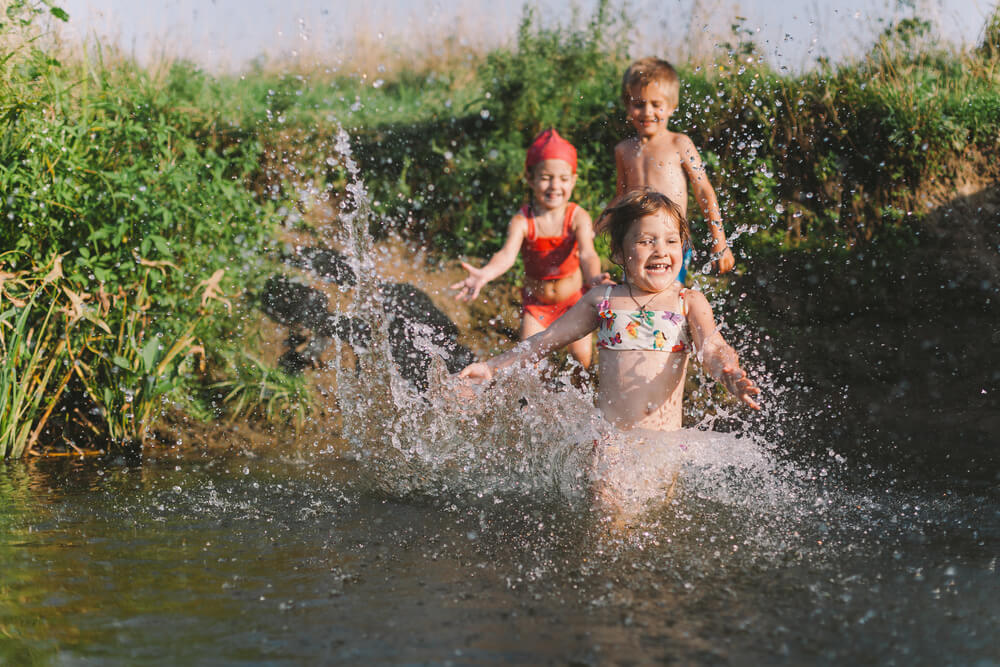
Water safety fundamentals are essential to all children. Kids need to have a thorough understanding of how to behave safely around large bodies of water such as swimming pools and the ocean while also knowing how to act in an emergency situation. Parents armed with information concerning the optimal conditions for swimming and the appropriate safety insight will always be able to act responsibly. We’ve got a comprehensive guide to water safety coming up including top tips, must-know safety info, and a range of handy water safety devices for you to check out.
Content:
- Why Is Water Safety So Important?
- Top 10 Water Safety Tips for Kids
- Top 5 Water Safety Tips For Toddlers
- How To Teach Kids To Be Safe In The Water?
- What Every Parent Must Know
- Water Safety Devices
Why Is Water Safety So Important?
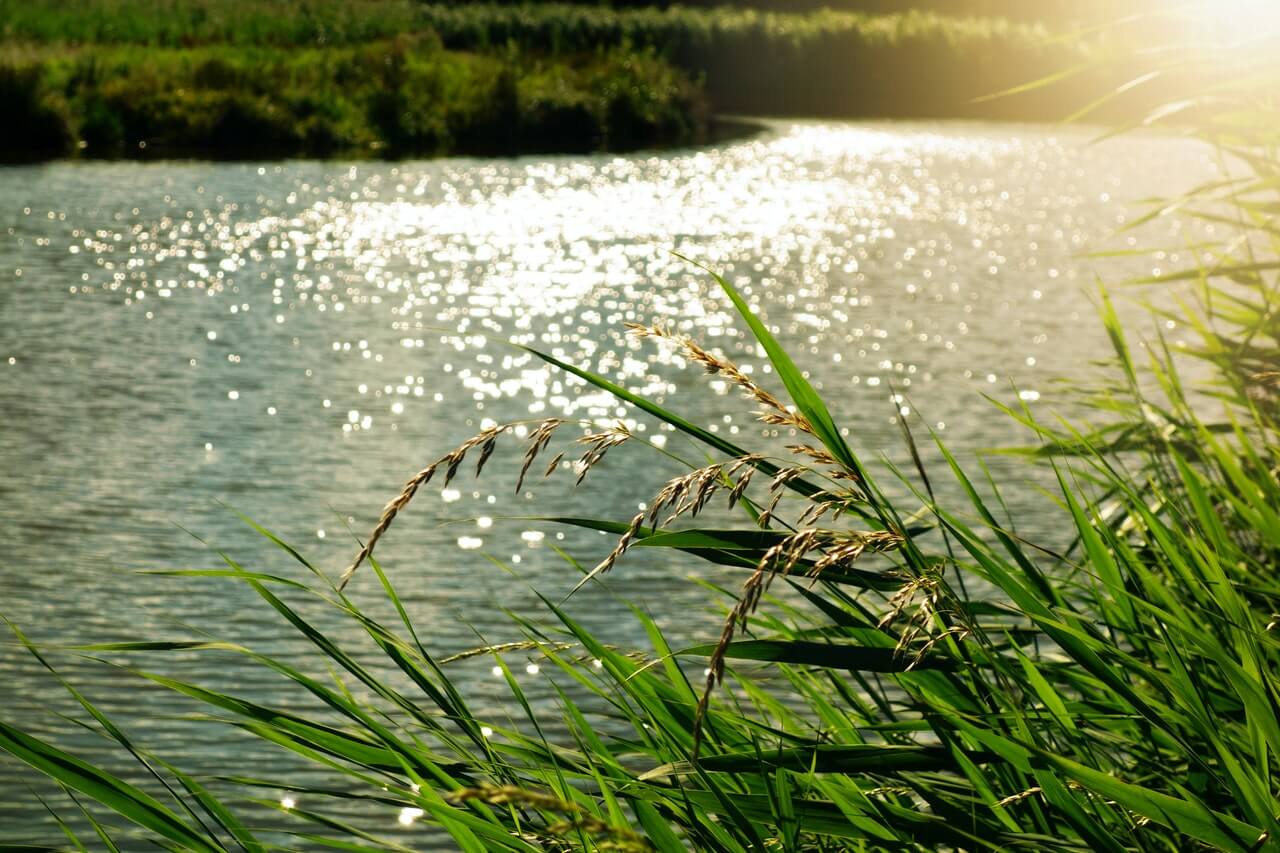
Prostock-studio/Shutterstock.com
The dire truth is that far too many children drown and find themselves at risk of drowning each and every day. Stanford Children’s Health reports that roughly 830 children under the age of 14 drown each and every year. That’s beside the approximate 3,600 near-drowning-related incidents that occur as well. Drowning isn’t only a risk in and around swimming pools and large bodies of water. Almost half of the drownings are reported as infants who have drowned in bathtubs. The highest risk group for drowning is children between the ages of one and four.
Studies show that just 12 weeks of juvenile swim training of children between the ages of 24 and 42 months resulted in vast improvements to their ability to swim, recovery whilst in water, and jump while in water — three core skills that reduce the risk of drowning.
Swimming is a skill that saves lives and vastly improves the potential for enjoying what life has to offer. Familiarity and comfort in large bodies of water reduce accidents and opens up endless avenues for watersports and other social fun.
Top 10 Water Safety Tips for Kids
Here are ten of the best water safety tips for kids of all ages. Every parent and their children should make this advice a core part of their water safety education.
Learn To Swim To A Point Of Complete Self-Sufficiency
All children must learn to swim from a young age. Consider enrolling older children such as those over four into a swim training program or swimming school The social environment and professional tuition go a long way towards building enthusiasm for swimming and watersports while raising competency to self-sufficiency reliably. Nonetheless, all kids must be taught to swim without any fear or difficulty left so before they reach an advanced age.
Only Swim With Supervision
Once children reach their teens and begin naturally craving independence, they should be at a point where swimming and basic first aid for water safety are second nature. Until this age, all kids must only swim when supervised by an adult. Responsible supervision requires the guardian to be attentive to kids at play in the water at all times.
Get Out Of The Water When Fatigued
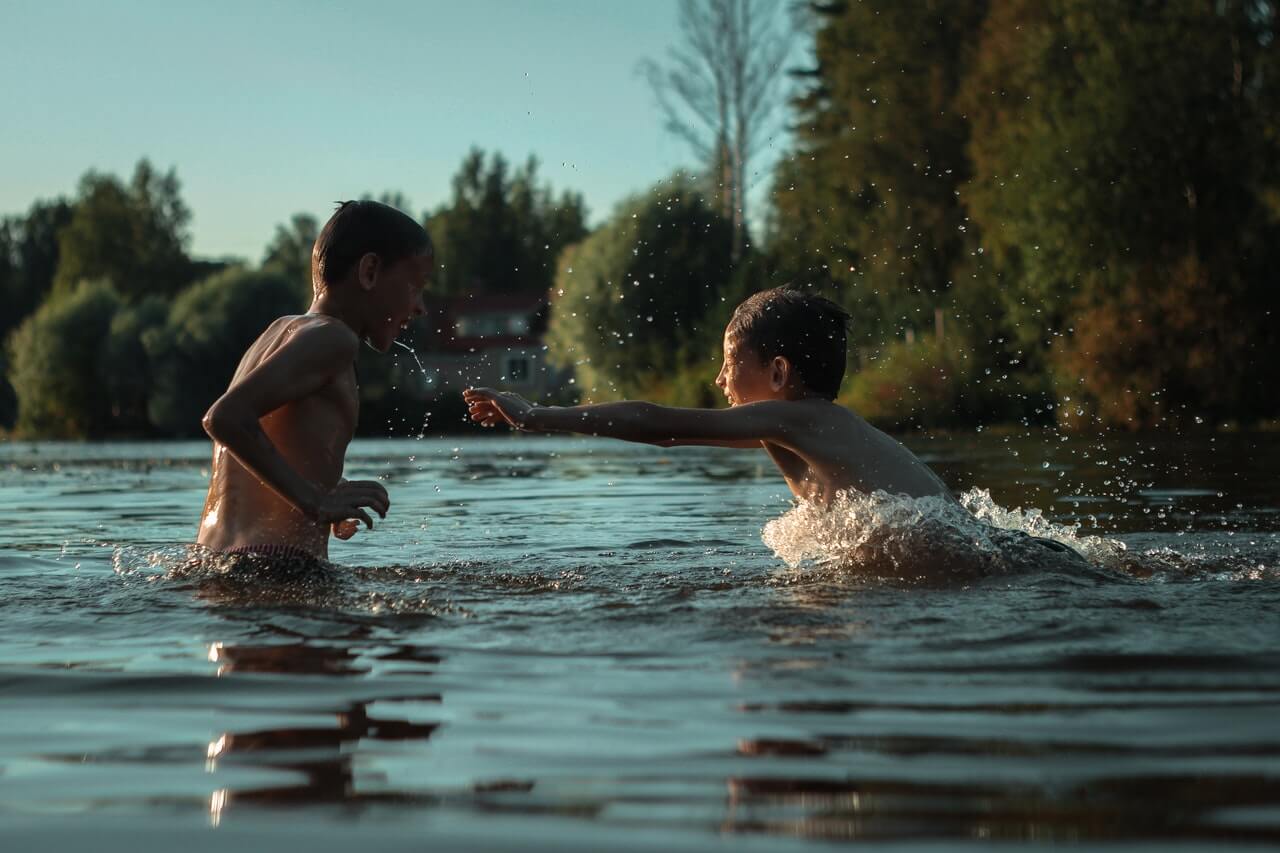
Prostock-studio/Shutterstock.com
Children do not always realize their limits within reasonable bounds of safety. Ensure that your kids and potentially their friends all understand that it’s vitally important to take a breather before over-exerting themselves. Fun and games can quickly turn into folly when children behave irresponsibly in deeper water.
Ensure Water Safety
Make sure the water is safe before your kids climb or jump in. Check whether the pool has recently been chlorinated or experienced any other treatments such as a shock treatment. Chemically treated water isn’t safe to swim in. Remove any large, dangerous debris and create a clear swimming area for children to play without a risk of hurting themselves or another.
Determine Depth First
Find the deep end. Climb in and determine the distance before the slope or dropoff and the rate of decline. A clear overview of the swimming pool or ocean front’s depth before things start becoming too deep for kids will guarantee safe responsible supervision.
Gauge Water Temperature Before Swimming
Jumping into an icy cold pool can knock anyone’s breath away, causing a dangerously quick drop in body temperature for children. Test the waters quite literally, ensuring that the pool is a reasonable temperature for swimming in. If the water is a little chilly, encourage and allow your children to climb in rather than jumping in and taking a plunge.
Don’t Jump In To Save Someone Else, Reach First
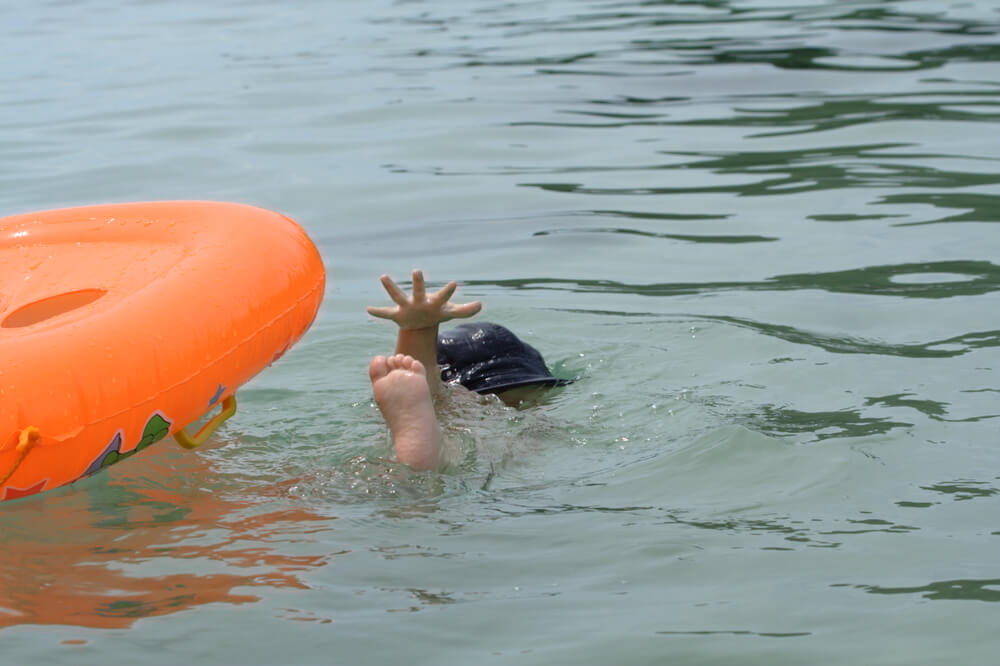
Prostock-studio/Shutterstock.com
Rescuing another person is not an endeavor that anyone should undertake unless they’re properly prepared on a mental and physical level. In a struggle to stay afloat, a drowning person will drown their rescuer unless adequately trained. Teach kids to avoid their first reaction and jump in after another in distress and to instead calmly send for help while reaching out and offering an arm to pull them to safety. If out of reach, an apparatus will work equally well, allowing the struggling swimmer to clutch on until out of the water.
Avoid Pool Drains, Equipment & Foreign Areas
Your children won’t always be familiar with the water that they’re swimming in. Pool drains and equipped suction devices can be extremely dangerous especially to younger swimmers. Nonetheless, even adults are susceptible to a pump system that’s strong enough so learning to exercise caution is essential. Similar sensibility goes for swimming in unknown bodies of water like rivers and dams at an older age. Let adults gauge the safety first and never swim in a region that’s unknown.
Adhere To Basic Pool Safety
Teach your kids the following rules and uphold them around water — don’t run near water. Don’t dunk others. Don’t dive in shallow water. Always follow the pool rules, and never, ever swim without supervision. Kids must learn to check the water temperature, depth, and look for a clear spot to climb in by themselves. No dangerous horseplay, and be sure that all children are equipped with at least basic safety know-how from a young.
Never Play Games That Involve Holding Your Breath
Breath-holding games become dangerous quickly. There’s no stopping a child who’s got an idea in mind, so rather educate your young ones over why breath-holding is dangerous. Help them to realize the fatal magnitude of something going wrong, and their natural common sense will keep them safe forever. Holding your breath over an extended period is not a game. No dunking. Ever.
Top 5 Water Safety Tips For Toddlers
Parents should know each of these ten top water safety tips for toddlers to grant themselves peace of mind in knowing that they’re equipped with everything necessary to keep their young ones safe in or around water.
Always Swim With A Life Jacket Equipped
Even the shallowest water can be dangerous for a panic-stricken toddler. Make sure that your little ones always have their life jackets equipped even when you’re with and supervising playtime. It’s as simple as no swimming without their jacket on, and remember — water wings and other swimming aids aren’t an acceptable substitute but rather an aid as the name suggests.
Swim With The Aid Of Water Wings
Water wings and swimming aids for toddlers are a great help to any child looking to have fun while they learn to swim. Not only does a selection of inflatables and wings give you enhanced water safety but it also ups the fun by making swimming more engaging. After all, every child loves toys.
Always Enter The Water Feet First
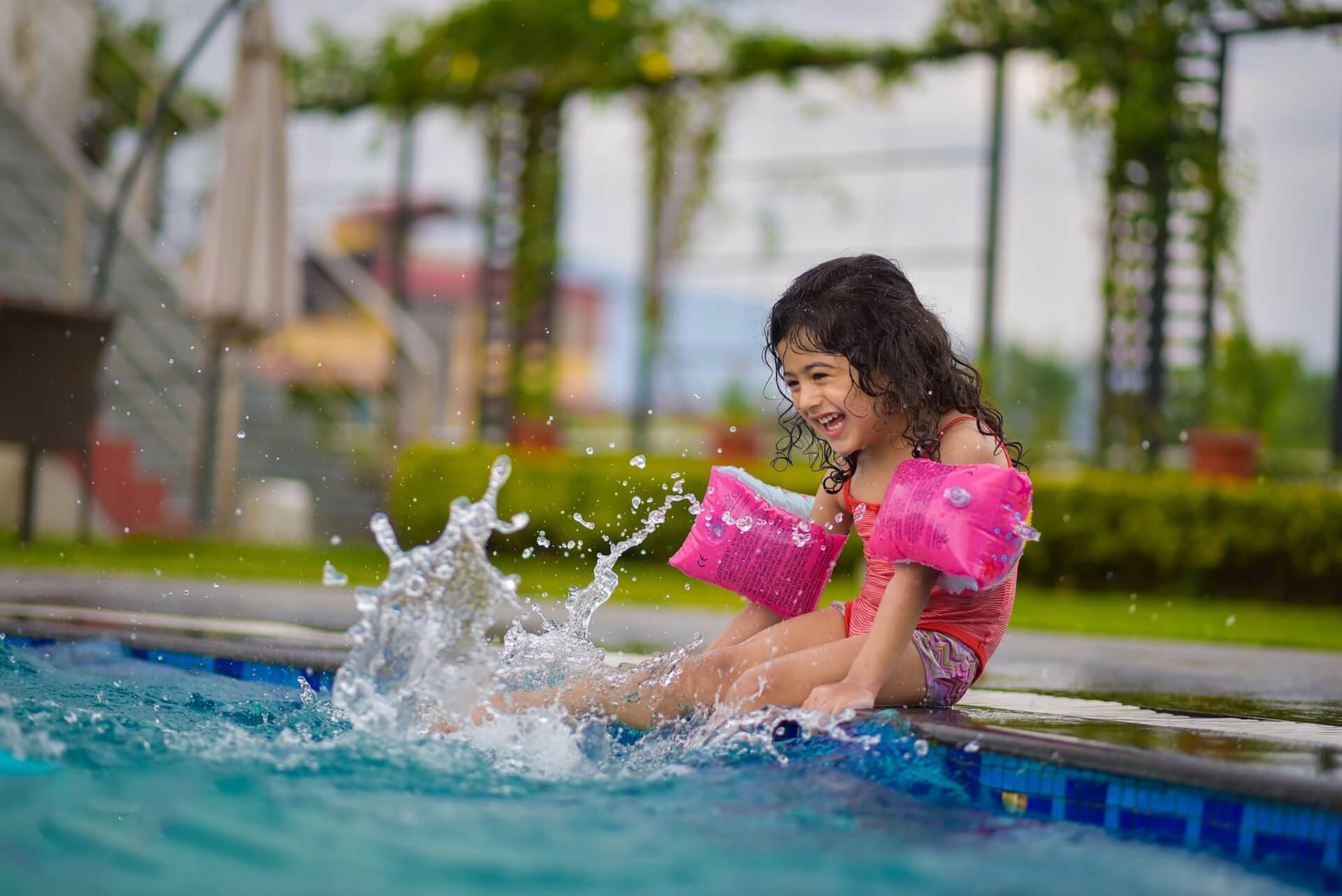
Prostock-studio/Shutterstock.com
Never underestimate the danger that water can pose to a young child. Have your toddler always enter the pool feet first, sustaining this rule until they’re much older. Plunging into ice-cold waters can incapacitate a child at an older age, while toddlers who decide to try their hand at swimming or crawling in the shallows could quickly find themselves swallowing water and in a panic leading to even more catastrophic consequences.
Walk When Near Water
As soon as most kids start having fun, they start running everywhere. While this may be fun and amusing, it’s most definitely not allowed near a swimming pool, splash pool, or any other body of water. A slip happens in an instant and can be as severe as fatal given the wrong unfortunate conditions. All children must learn to walk near water and exercise good caution by avoiding horseplay on or around slippery surfaces from a young age.
Parents Must Always Keep Toddlers In Direct Sight
Supervising a toddler at play in the water, even a bucket of water takes keeping your eyes on them at all times. Toddlers can drown in as little as two inches of water. Just because you can hear them playing a stone’s throw away, this doesn’t mean that a preventable terrible accident can occur. The foresight of an adult or parental figure goes a long way towards keeping toddlers who are still learning how to command their own bodies safe.
How To Teach Kids To Be Safe In The Water?

Prostock-studio/Shutterstock.com
Parents will find these fundamental concepts extremely helpful to teaching kids to be safe in the water while having fun doing so.
Teach Your Child Not To Swallow Water
Not swallowing water doesn’t always arise as first logic, especially not to a panicking child who can’t swim properly. It is also vital for children to understand the health risks of ingesting chemically-treated swimming pool water and saltwater. Once they understand why they’ll be far less likely to allow themselves to swallow water.
Teach Your Child To Float
One of the very first swimming lessons all kids should learn is how to turn onto their back and float. Floating effortlessly can literally keep a stranded person, even one who can’t swim to a good degree of competency, afloat for an extended period allowing time for help to arrive. Floating exerts minimal energy, allowing kids to recoup from fatigue and enjoy safer, longer playtimes.
Give Your Children Swimming Lessons
Swimming lessons are available to children from as young as one year old. The age at which you put them through classes is up to you, but early swimming lessons are recommended to heighten water safety and help develop a healthy affinity for water early in life.
Equip Your Child With Emergency Skills
Gauge your child’s personal degree of competency to pick out your lessons carefully, but equip children along every step of the way with actionable information concerning how to handle emergency situations. From CPR and other first aid techniques to the basics like how to help a drowning victim, ensure your kids know everything to react calmly and responsibly.
What Every Parent Must Know
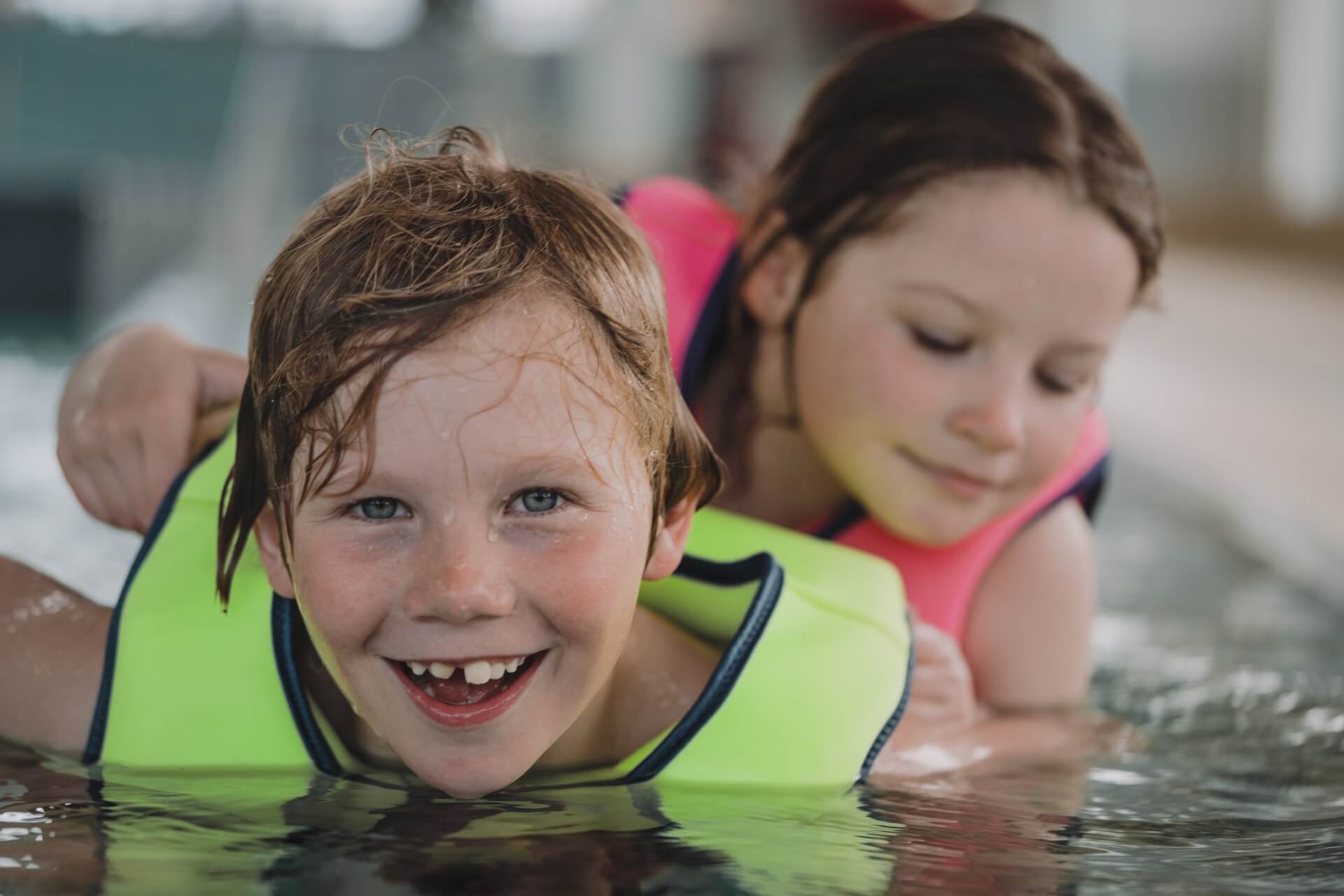
Prostock-studio/Shutterstock.com
There are certain water safety facts and essential information about handling water-based emergency situations that every parent must know. Here’s all the know-how about how to keep kids safe.
The Temperature Of The Water For Children
Parents can consider 80°F a safe temperature for children to swim in but if the water temperature can be controlled, 90°F (on par with a child’s body temperature) is far more comfortable. If you’re judging by touch, use your elbow. Be sure to submerge it to a considerable degree and hold it there for several seconds to get a good idea of how warm or cold the water is.
Duration Of Continuous Stay Of Children In The Water
The temperature, chemical balance, and natural state of the water relative to the age of your child and their skin type all determine how long they can stay in the water continuously. Too long in chemically treated water can quickly dry out a young child’s skin leading to itchiness and irritation. Keep an eye on your kids and watch for any signs of nagging discomfort that they may be overlooked while in the spirit of play.
How To Choose A Suitable Place For Swimming And What You Need To Have With You
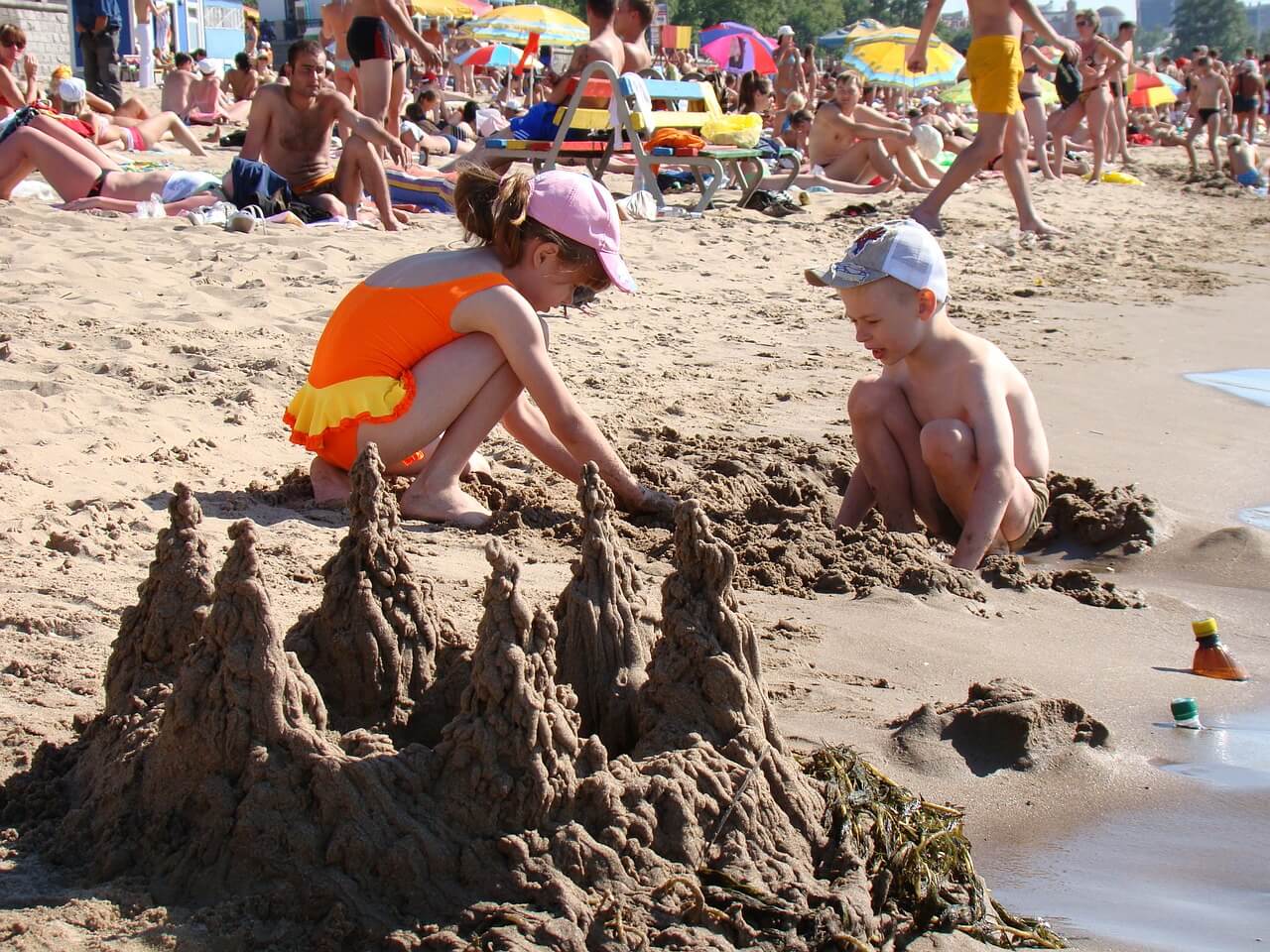
Prostock-studio/Shutterstock.com
If you’re placing a swimming pool, position it close to your house within range of a window that’s used a lot such as a kitchen or living room. This makes supervision much easier. Otherwise, frequent a friend or family member’s pool. If this isn’t possible, pay a visit to the public swimming pools in your area and perhaps alternate swimming locations like beaches if on the coast, or dams if inland. Find a swimming area that is clean, responsibly managed, and one that offers amenities for the whole family to be comfortable.
We’ll all have our own personal favorites to take with swimming, but here are the essentials to start your checklist:
- Swimwear
- Lifejackets
- Sunscreen
- Swimming Aids
- Inflatables
- Extra Shoes
- Ample Drinking Water
- Swimming Cap
- Goggles
- Dry Clothes & Backup Clothes
- Towels & Backup Towels
- Fully Charged Cellphone Or Smart Device
- Paracetamol And Anti-Allergy Medication
How To Recognize That A Child Is Drowning?

Prostock-studio/Shutterstock.com
The number of children that die from drowning each year is shocking. With drowning arising as the second highest cause of death among children under the age of fourteen (second only to vehicle accidents), all parents must know the warning signs of drowning.
If you notice any of the following distress signals, remove your child from the water immediately:
- Difficulty keeping head above water with mouth dipping below water level.
- Tilted head reaching to keep out of the water with mouth open.
- Eyes either wide-open with fright or tightly kept close.
- Hair in front of eyes constantly without child trying to clear vision.
- A body positioning bordering on vertical with barely any leg motion at all.
- Futile attempt to swim in a direction making negligible progress.
- Gasping for air in big gasps or hyperventilation.
- Constant rolling attempt to tip over onto child’s back.
- Staying at the bottom of the pool for an extended period.
- The onset of fatigue making swimming difficult as a child tries to stay above water.
Behavior In A Critical Situation, Essential First Aid
- Firstly, get the child out of the water while ensuring that they don’t swallow any more water in the process.
- Send for help if you’re not by yourself and if you are get hold of a cellphone and contact emergency services.
- Ensure that they’re still breathing by placing your ear nearby to the child’s mouth and nose to see if you can feel the air.
- Place the child flat on their back on a level surface.
- Give the child five mouth-to-mouth resuscitation rescue breaths and look for any gagging or coughing – this is a good sign.
Rescue Breaths For Babies Under One-Year-Old
- Keep the baby’s head in a natural position and tilt their chin upward.
- Draw a breath while covering the baby’s mouth and nose with your entire mouth (if this isn’t possible, cover one with your mouth and seal the other to prevent air from escaping).
- Blow a single breath steadily (preferably into the mouth and nose) over the duration of a second noticing the child’s chest rising slightly.
- Take your mouth away while keeping the child’s head tilted and chin elevated (you’ll notice the child’s chest fall).
- Repeat four more rescue breaths watching for the rise and fall of the child’s chest to confirm the proper administration of the emergency procedure.
Rescue Breaths For Children Over One-Year-Old
- Keep the child’s head in a natural position and tilt their head while lifting their chin.
- Use your thumb and index finger of the hand not supporting the child’s head to block their nasal passages.
- Open the child’s mouth slightly.
- Draw a large breath and cover their mouth with your mouth ensuring to create a seal.
- Blow steadily into their mouth over the course of a second observing the rise of their chest.
- Maintain the child’s head tilt and chin lift as you remove your mouth and watch for their chest to fall.
- Repeat the four more breaths while ensuring that the child’s chest rises and falls as if they were breathing regularly.
If after five rescue breaths the child starts showing signs of life, continue providing rescue breaths until they are breathing properly by themselves. Once breathing begins, turn the kid on their side into the recovery position while you wait or send for help while helping them become comfortable and recover completely.
Perform Chest Compressions
If five rescue breaths bring no signs of life, begin chest compressions immediately. Use the instructions provided to supply a set of compressions followed by two rescue breaths until the child begins recovering.
To perform chest compressions correctly, locate the area where the bottom-most ribs join in the center of the chest and then measure one finger’s width higher — that is the region where the breastbone must be compressed.
Chest Compressions For Children Under One-Year-Old
- Place two fingers (not your hand) on the baby’s breastbone.
- Press down on the chest rapidly being careful to avoid the end of the breastbone, pushing with enough force to depress to roughly one and a half inches.
- If one cannot reach the proper depth of compression, use the heel of your hand instead of your fingertips.
- Perform thirty chest compressions aiming to reach a rate of one hundred per minute while ensuring that the chest rises and falls in between each compression.
- Look for any signs of breathing, and follow-up with two rescue breaths before continuing another set of compressions if the child is still not resuscitated.
Chest Compressions For Children Over One-Year-Old
- Use the heel of your palm to depress the middle of the child’s chest aligning it to the nipples to ensure proper placement.
- Optionally, cover your hand with your other hand to help compressions.
- Rapidly begin depressing the chest to a depth of roughly two inches ensuring that the chest rises and falls with each compression.
- Perform thirty chest compressions aiming to reach a rate of one hundred compressions a minute.
- After thirty compressions, look for signs of life, and follow with two rescue breaths and another set if not yet breathing.
Sets of chest compressions and rescue breaths must be performed until either the child begins breathing by themselves, or until help arrives.
Water Safety Devices
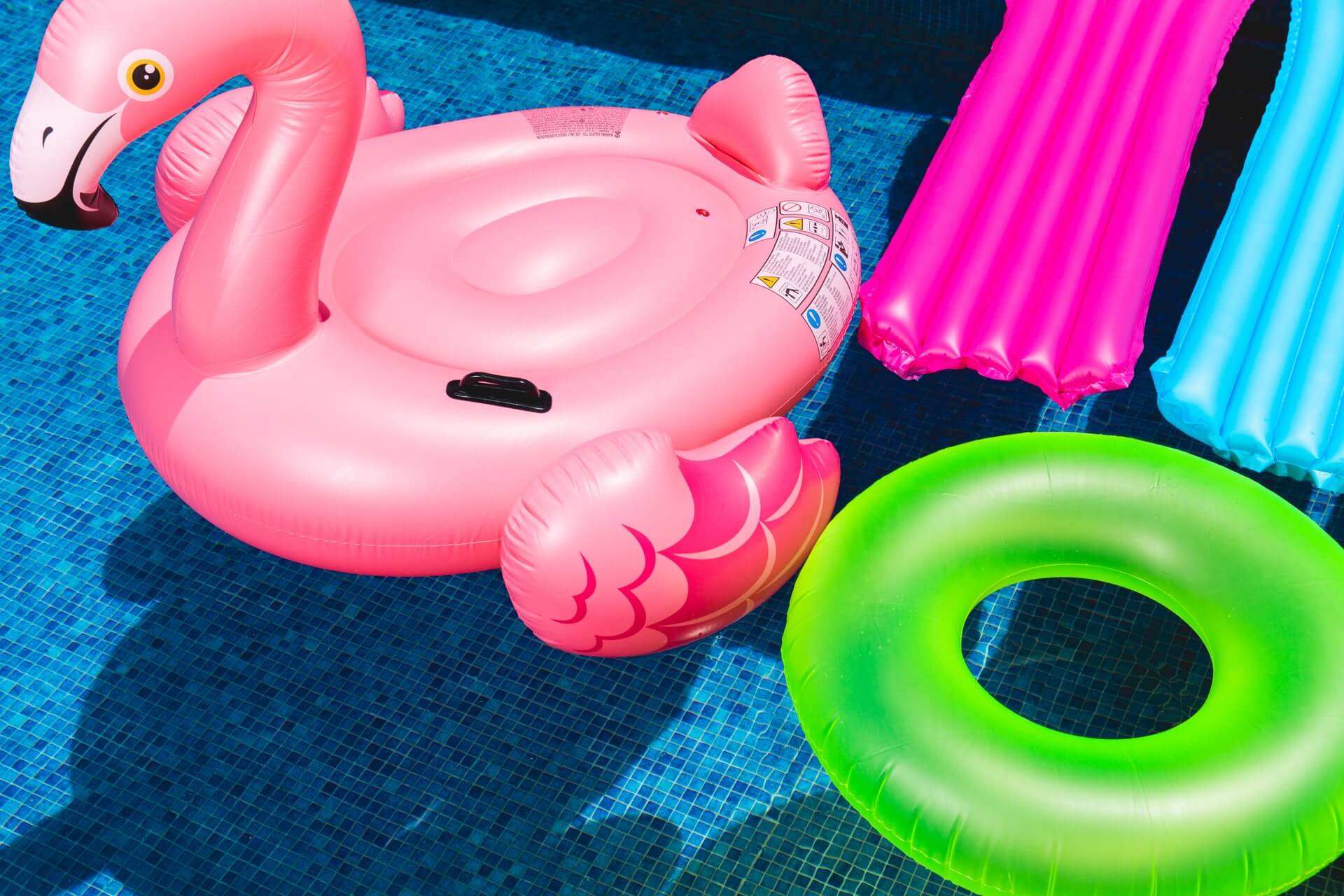
Prostock-studio/Shutterstock.com
Life Jackets
A life jacket or personal floatation device must fit snugly suiting the size, weight, and age range of the child. Life jackets are an essential water safety device that all children need to own and wear while learning to swim.
Buoyancy/Float Suits
A buoyancy or float suit is an extremely comfortable, reliable safety aid for children of all ages that helps kids keep their heads above water while learning to swim. It’s not a replacement for a life jacket and should be used as a safety aid only — not a device to rely on solely for water safety.
Swim Tube Trainer
Tube trainers help young children gain confidence in the water before learning to swim without the aid of a floatation device. It’s the ideal product to help beginners become comfortable in the water by giving them the freedom to explore safely.
Swim Belts
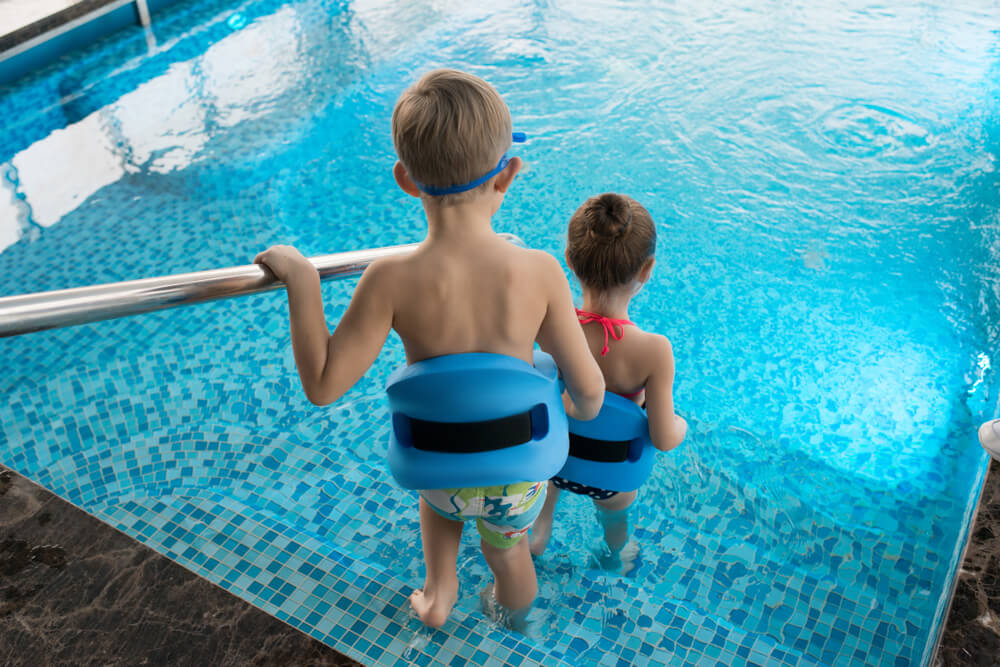
Prostock-studio/Shutterstock.com
Swim belts are a fantastic swimming aid that helps swim training immensely by stabilizing a child in the water. Whether learning how to breathe bilaterally or building speed and endurance, swim belts are not a safety device to prevent drowning but rather to assist in learning to swim better once a child has the fundamentals practiced.
Back Floats
Back floats are designed in a similar style to a backpack, helping kids to remain horizontal as they learn to swim. Complete freedom of motion is inhibited which means that all swimming opportunities aren’t available but it does help kids build confidence and learn to keep their head above water easier.
Puddle Jumpers
Puddle jumpers are a handy device to help very young children learn how to stay in an upright, vertical position while in the water. Don’t rely on them for safety solely but rather use them as an aid to help a child develop good posture while swimming.
Water Wings/Arm Bands
Inflatable armbands are an excellent floatation aid but, like many other inflatables, should not be relied on by themselves to keep children safe in the water. Use water wings to help a child build confidence, and to teach them to float vertically. Ensure that to remove armbands early enough in training or an unhealthy dependence can develop.
Pool Noodles
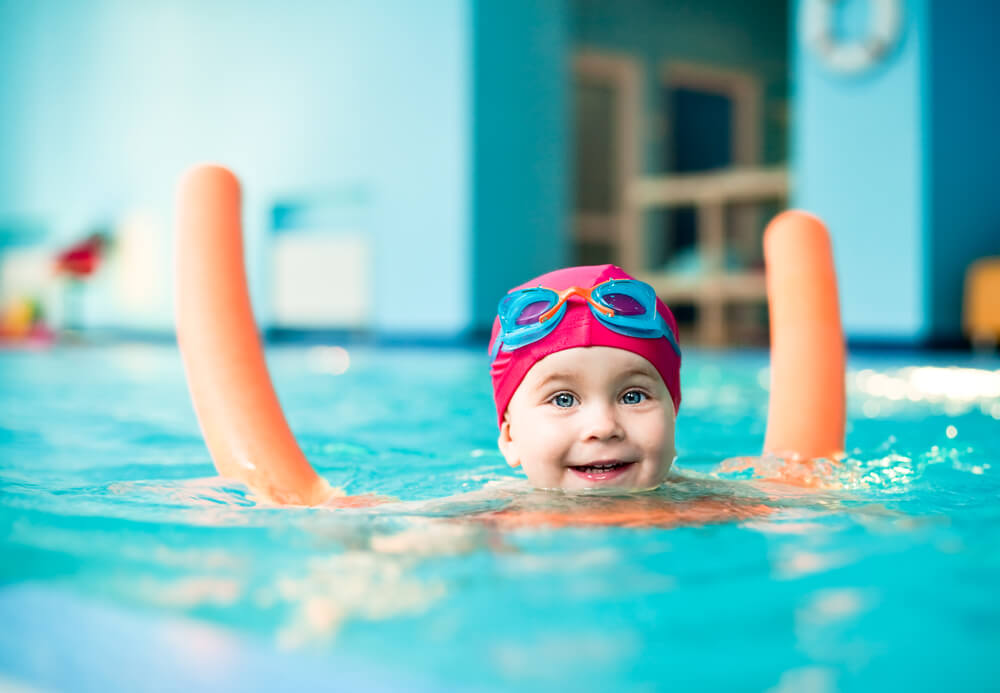
Prostock-studio/Shutterstock.com
Every child loves a pool noodle but once again, this isn’t a floatation device that guarantees water safety. It is, however, a great aid for fun and games while at the same time helping younger children recoup fatigue while learning to swim properly. Pool noodles are useful for everything from kick training to basic horizontal and vertical alignment when in the water.
Kickboards
Use a kickboard to help a developing swimmer exercise their legs and improve speed, power, endurance, and their kicking technique while in the water. Even advanced swimmers can use kickboards to work out their legs and improve their form.
Floaties
Floatation devices make learning to swim fun but they aren’t ideally safety devices that you should put your complete faith in for keeping kids safely afloat. They help while learning to swim and aid swimming games but are no replacement for a life jacket.
The water safety insight that your children learn, and the proficiency that gained swimming at an early age will stick with them through all of life. Gaining confidence in the water from as young as possible vastly improves a child’s ability to swim and navigate themselves through tricky situations safely should they arise as a young adult. We encourage you to share any water safety tips that you’ve picked up while teaching your own children how to swim — your guidance will go a long way towards helping other parents and their kids enjoy their time in the water safely.
Проверьте электронный ящик



















